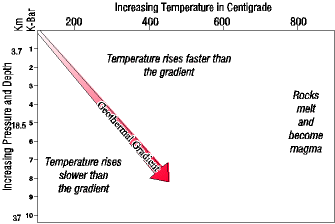
Minerals and rocks are stable only under the conditions at which they form. Change the conditions and the rocks will change to adapt to the new conditions.
Metamorphism occurs when any previously existing rock, the parent rock, is buried in the earth under layers of other rock. The deeper the rock is buried the hotter it gets, and the higher the pressure becomes. Eventually, rock must adjust to the new conditions, whether it is baked, or squeezed, or both, and in the process becomes a metamorphic rock.
 The temperature is going up because the center of the earth is molten, and the closer we get to that heat the hotter it gets. This rise in temperature with depth is called the geothermal gradient.
The temperature is going up because the center of the earth is molten, and the closer we get to that heat the hotter it gets. This rise in temperature with depth is called the geothermal gradient.In the phase diagram to the right, temperature increases to the right and pressure and depth increased downward. The red arrow is the geothermal gradient. Observe on the far right that the temperature becomes hot enough to melt the rock.
 The pressure is going up because, . . . well, imagine having a pile of rocks ten miles thick sitting on your head. This is hydrostatic pressure. It is equal in all directions. But, there is also directed pressure, squeezing pressure that happens when, say, two continents collide, as in the cross ssection to the right.
The pressure is going up because, . . . well, imagine having a pile of rocks ten miles thick sitting on your head. This is hydrostatic pressure. It is equal in all directions. But, there is also directed pressure, squeezing pressure that happens when, say, two continents collide, as in the cross ssection to the right.As an example of the principle that minerals and rocks are stable only under the conditions at which they form, take the igneous rock granite. It is only stable at the high temperature at which it forms. But expose it at the earth's surface and it becomes unstable, and weathers to form, among other things, clay, a mineral stable at the earth's surface. Clay is deposited to form the sedimentary rock shale.
But, as more and more sediment comes down from the mountains the shale gets buried deeper and deeper, and the temperature and pressure rise to the point where the clay that composes the shale is no longer stable. The clay must adjust, adapt to the higher heat and pressure conditions, and it does so by recrystallizing into a new mineral, chlorite. Chlorite is a metamorphic mineral and composes the metamorphic rock slate.
And, if the temperature and pressure continue to rise the slate will transform into a phyllite, then a schist, then a gneiss, and finally melt to magma, which cools to form an igneous rock. All these transformations are the rock cycle which says all rocks can be transformed into other rocks (rock cycle discussion) as environmental conditions change When metamorphism runs its entire course a sedimentary rock is baked into a metamorphic rock, and eventually melted into an igneous rock.
Thus, we see that as long as the earth remains geogically active, rocks are going to have to continuously adjust to changing conditions of heat and pressure. Any rock can be metamorphosed, including igneous, sedimentary, and metamorphic, and each can be metamorphosed by several different combinations of heat and pressure. Because of all the combinations, metamorphic rocks can be complex. But metamorphism also produces some of the most spectacular and beautiful rocks we can find, and we have all seen them since they are common building stones.